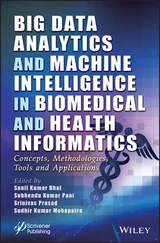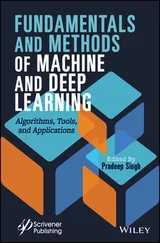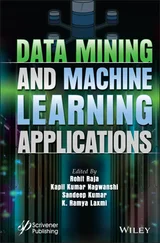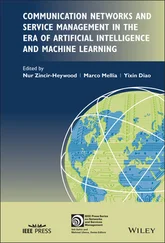Advanced Analytics and Deep Learning Models
Здесь есть возможность читать онлайн «Advanced Analytics and Deep Learning Models» — ознакомительный отрывок электронной книги совершенно бесплатно, а после прочтения отрывка купить полную версию. В некоторых случаях можно слушать аудио, скачать через торрент в формате fb2 и присутствует краткое содержание. Жанр: unrecognised, на английском языке. Описание произведения, (предисловие) а так же отзывы посетителей доступны на портале библиотеки ЛибКат.
- Название:Advanced Analytics and Deep Learning Models
- Автор:
- Жанр:
- Год:неизвестен
- ISBN:нет данных
- Рейтинг книги:5 / 5. Голосов: 1
-
Избранное:Добавить в избранное
- Отзывы:
-
Ваша оценка:
- 100
- 1
- 2
- 3
- 4
- 5
Advanced Analytics and Deep Learning Models: краткое содержание, описание и аннотация
Предлагаем к чтению аннотацию, описание, краткое содержание или предисловие (зависит от того, что написал сам автор книги «Advanced Analytics and Deep Learning Models»). Если вы не нашли необходимую информацию о книге — напишите в комментариях, мы постараемся отыскать её.
The book provides readers with an in-depth understanding of concepts and technologies related to the importance of analytics and deep learning in many useful real-world applications such as e-healthcare, transportation, agriculture, stock market, etc.
Audience
Advanced Analytics and Deep Learning Models — читать онлайн ознакомительный отрывок
Ниже представлен текст книги, разбитый по страницам. Система сохранения места последней прочитанной страницы, позволяет с удобством читать онлайн бесплатно книгу «Advanced Analytics and Deep Learning Models», без необходимости каждый раз заново искать на чём Вы остановились. Поставьте закладку, и сможете в любой момент перейти на страницу, на которой закончили чтение.
Интервал:
Закладка:

Figure 3.5 Experimental result.
3.4.5 Multi-Criteria Clustering Approach by Wasid and Ali
In this research activity, they suggested a clustering method to use multiple-criteria rating into conventional recommendation system successfully. To generate more on the mark recommendations, they evaluate the intra-cluster client matches by applying Mahalanobis distance approach. Then, they collated their method with the conventional CF [2].
Now, we will take a look on their experimental evaluation and result for its efficiency.
3.4.5.1 Experimental Evaluation
To implement this proposed approach, they have used Yahoo! Movies dataset. This dataset consists of 62,156 rating provides by 6,078 users on 976 movies. To make it simple, they have extracted those clients that have rated to minimum 20 movies. This condition satisfies 484 users and 945 movies, and they have total 19,050 ratings. Then, every client’s rating is splitted arbitrarily into training and testing set. They took 70% of data for training purpose and remaining 30% of data for testing purpose. Then, they calculate the distance between clients successfully. They selected top 30 most equivalent users for the neighborhood set formation. To evaluate this proposed approach, they used the most popular Mean Absolute Error (MAE) performance matrix. MAE is very popular because of its simplicity and accuracy as we have seen before. It matches the goal of the experiment. The mean absolute error estimates the derivation of actual and predicted client ratings [2].
3.4.5.2 Result and Analysis
The dataset which they have used contain both single-criteria and multiple-criteria user provided ratings. Table 3.4represents the difference between their way with the conventional approach for both non-clustering and clustering environment. Here, they have compared their experimental result with Pearson collaborative recommender (PCRS) approach. Table 3.4conveys the result between PCRS with their proposed Mahalanobis distance recommendation scheme (MDRS). It is very transparent that their method MDRS performed much superior than traditional PCRS. These results are based on mean absolute error method. This proposed MDRS approach works better for both on clustering and clustering environments which is shown in Figure 3.6[2].
They also have shown the graphical implementation of this table which is in both non-clustering and clustering environments. The Mahalanobis distance–based method gives better result than the Pearson collaborative recommender approach. If the mean absolute error values are lower, then it means it is a better result. By that result, we can also see that the non-clustering–based technique always have less performance than clustering approaches. So, the clustering approach is better [2].
Table 3.4 Comparison among clustering and non-clustering approach.
| Approach | MAE (non-clustering) | MAE (clustering) |
|---|---|---|
| PCRS | 2.4577 | 2.2734 |
| MDRS | 2.3094 | 2.1751 |
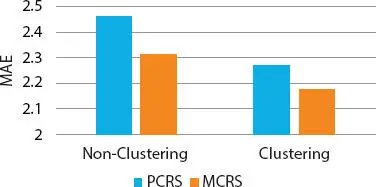
Figure 3.6 Result.
They have consolidated the multiple-criteria ratings into the conventional CF-based recommender system using K-means algorithm. Their method treats the third dimensional as multi-criteria, the clustering parameters as the clustering parameter of the clients, to handle the dimensionality. Their approach depends on thinking like each user has unique opinion and criteria. Therefore, to compare each user, the most important concern of this work is to find out clients’ segments with alike client. Mahalanobis distance method is used here to create most exact neighbors for every client within the cluster. In the result, we can clearly see that this technique is more effective and accurate than the traditional approach [2].
3.5 Advantages of Multi-Criteria Recommender System
Multi-criteria recommender system is used to make user experience easier or make things easy for each and every user. If we take a look on business perspective, then this system is used to grow a business.
Table 3.5 Comparison among existing methods in MCRS.
| Author name | Research work | Work done | Method name | Challenges |
|---|---|---|---|---|
| Yong Zheng | Utility-Based Multi-Criteria Recommender System (2019) | Implemented a new recommender system approach which dominates many the traditional approaches. | Utility-based approach. | Issue of overexpectation, which may contribute finer-grained recommendation models |
| Dharahas Tallapally, Rama Syamala Sreepada, Bidyut kr. Patra, Korra Sathya Babu | User Preference Learning in Multi-Criteria Recommendation Using Stacked Auto Encoders | Implemented a recommender system using extended version of autoencoder named as stacked autoencoder. | Stacked Autoencoder, An unsupervised deep neural network approach. | This approach is still now in improvement state, and this approach cannot work in user review system. |
| Mohammed Wasid, Rashid Ali | An Improved recommender System based on Multi-criteria Clustering Approach (2018) | Implemented Multicriteria recommender system using Clustering approach which gives getting better result than traditional recommender Systems. | K-means Clustering, Mahalanobis Distance. | This particular algorithm assumes that each client has individual opinion which is dissimilar to each other for every criterion. |
| Yong Zheng | Situation-Aware Multi-Criteria Recommender System: Using Criteria Preferences as Contexts (2017) | Implemented a recommender system using criteria preference as context approach that gives a better result. | Aggregation approach, Full Contextual Model, Partial Contextual Model, Hybrid Contextual model. | Does not work well for all the cases. Its need improvement. |
| CataldoMusto, Marco de Gemmis, Giovanni Semeraro, Pasquale Lops | A Multi-criteria Recommender System Exploiting Aspect-based Sentiment Analysis of Users’ Reviews (2017) | Implemented a recommender system using users review. | Taking out Aspects and Sentiment from Reviews, then feed it in multi-criteria recommender algorithm based on collaborative filtering technique. | This research work is still in improvement state. It can be improved further. |
In business point of view, if a customer comes in any platform, then the main work of the owner and the staff is to satisfy the customer needs. They will make sure that the customer must have a good experience and got their desired thing. This is the main work of a recommender system. For this particular reason, many companies are adopting this multi-criteria recommender system [33].
Here are some benefits in businesses perspective that can be achieved by using MCRS:
3.5.1 Revenue
MCRS has a big role in generating the revenue. Years of research, execution, and experiments, many researchers from all over the world made various types of recommender systems. Many different types of algorithms are executed and explored to get good accuracy. When a customer came to buy a particular thing then the MCRS shows him some similar things and accessories so that the customer will buy that too. This is one of the job of MCRS and also one of the effective ways to generate better revenue.
Читать дальшеИнтервал:
Закладка:
Похожие книги на «Advanced Analytics and Deep Learning Models»
Представляем Вашему вниманию похожие книги на «Advanced Analytics and Deep Learning Models» списком для выбора. Мы отобрали схожую по названию и смыслу литературу в надежде предоставить читателям больше вариантов отыскать новые, интересные, ещё непрочитанные произведения.
Обсуждение, отзывы о книге «Advanced Analytics and Deep Learning Models» и просто собственные мнения читателей. Оставьте ваши комментарии, напишите, что Вы думаете о произведении, его смысле или главных героях. Укажите что конкретно понравилось, а что нет, и почему Вы так считаете.

